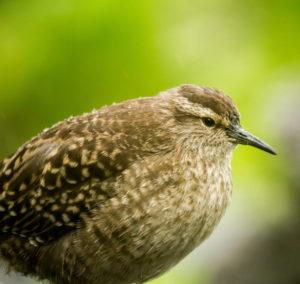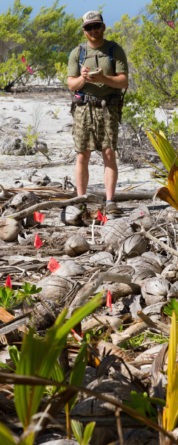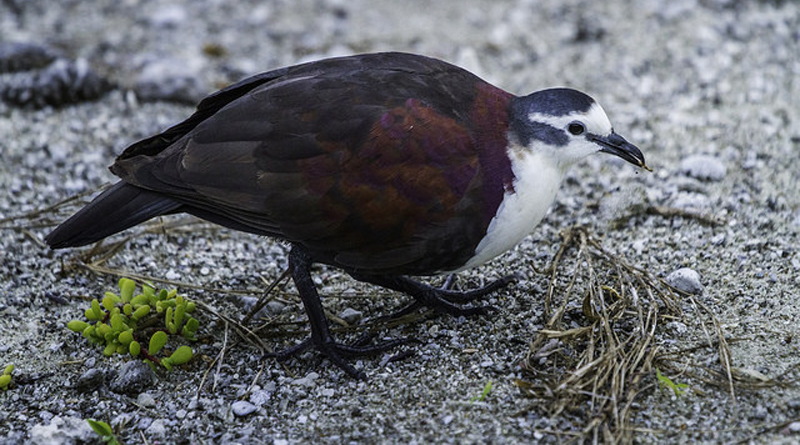RARE BIRDS REBOUND ON PACIFIC ISLANDS
Five remote Pacific islands are once again safe havens for four of our world’s rarest bird species following the success of one of the most ambitious island restoration projects ever implemented.
Just two years after ambitious efforts by a team of international conservation organisations to rid French Polynesia’s Acteon & Gambier island groups of invasive mammals began, five of six targeted islands are now confirmed as predator-free—a ground-breaking one thousand hectares in total.
Early signs already indicate that rare birds found nowhere else in the world (endemic) and other native plants and animals are recovering as the remote islands return to their former glory.
 The Polynesian Ground-dove Alopecoenas erythropterus (locally known as Tutururu) is one of the rarest birds on the planet with fewer than 200 individuals left. Predation and competition by destructive, non-native (invasive) mammals in French Polynesia have driven this and other rare, endemic bird species to the brink of extinction. The species is listed by BirdLife International as Critically Endangered on the IUCN Red List—a category that signals an extremely high risk of extinction within our lifetimes.
The Polynesian Ground-dove Alopecoenas erythropterus (locally known as Tutururu) is one of the rarest birds on the planet with fewer than 200 individuals left. Predation and competition by destructive, non-native (invasive) mammals in French Polynesia have driven this and other rare, endemic bird species to the brink of extinction. The species is listed by BirdLife International as Critically Endangered on the IUCN Red List—a category that signals an extremely high risk of extinction within our lifetimes.
“The Acteon Gambier island group is home to the last viable population of Polynesian Ground-dove, a species once much more widespread in the Pacific”, said Steve Cranwell, BirdLife International’s Invasive Species Manager.
“This bird’s remaining predator-free habitat was so small that without this intervention, a cyclone, prolonged drought, or accidental rat or avian disease introduction could trigger extinction”.
Introduced mammalian species alone are believed to be responsible for 90% of all bird extinctions since 1500. Early human explorers introduced invasive species such as rats to the remote Acteon & Gambier islands (and thousands more around the world), upsetting the natural balances of the islands and threatening the native plants and wildlife that evolved without defences against land predators.
“After extensive monitoring, a survey has confirmed great success on five of the six islands”, reported Dr David Beaune, Director SOP Manu. “This is a tremendous achievement that will provide a permanent solution to the alarming declines of native species on these islands due to predation and competition from invasive species”.

“The project has more than doubled the secure habitat for both the Polynesian Ground-dove and the Tuamotu Sandpiper Prosobonia parvirostris (locally: Titi), a globally Endangered landbird”, said Cranwell.
“The islands look vibrant with new native vegetation, and both bird species have now established and are increasing on the island of Tenarunga—something that has not been possible for decades”.

The benefits extend beyond nature alone. “Without rats, local land managers reported a doubling of their copra (coconut kernel) production in 2016—a major source of income for these isolated communities”, said Pere Joel Aumeran Vicar General for the Catholic Church.
“While the success of this project is vital to securing the future for these globally threatened birds, it also provides important safe habitat for other endemic species in a region where there is very little invasive-predator-free habitat”, explained Richard Griffiths, Island Conservation’s Project Director.
“The success also serves as an indicator that invasive-species-driven extinctions on other remote islands can be avoided if this operation is replicated at scale”.
“We now need to increase the habitat range of these species by translocating small populations to islands where they were previously found—a conservation technique that has proven highly effective in Polynesia”, said Dr. Beaune.
“Plans are underway to re-introduce the Tutururu and Titi to Temoe, and to attract other Endangered seabirds such as the Polynesian Storm-petrel Nesofregetta fuliginosa to these predator-free islands”.
With invasive mammals now eradicated from the five islands, the coalition’s attention is shifting to biosecurity—preventing re-invasion through monitoring, education (brochures and signs for tourists), and stringent inspections of incoming vessels.

